Physics Exam > Physics Questions > A bob is attached to one end of a string othe...
Start Learning for Free
A bob is attached to one end of a string other end of which is fixed at peg A. The bob is taken to a position where string makes an angle of 30° with the horizontal. On the circular path of the bob in vertical plane there is a peg ‘B’ at a symmetrical position with respect to the position of release as shown in the figure. If vc and va be the minimum speeds in clockwise and anticlockwise directions respectively, given to the bob in order to hit the peg ‘B’ then ratio vc : va is equal to :
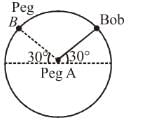
- a)(1 : 4)
- b)(1 : 2)
- c)(1 : 3)
- d)(1 : 1)
Correct answer is option 'B'. Can you explain this answer?
| FREE This question is part of | Download PDF Attempt this Test |
Verified Answer
A bob is attached to one end of a string other end of which is fixed a...
For anti-clockwise motion, speed at the highest point should be  Conserving energy at (1) and (2) :
Conserving energy at (1) and (2) :
 Conserving energy at (1) and (2) :
Conserving energy at (1) and (2) :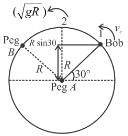
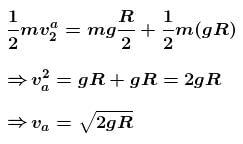
For clock-wise motion, the bob must have atleast that much speed initially, so that the string must not become loose any where until it reaches the peg B.
At the initial position :

vc being the initial speed in clockwise direction.
For Vc min : Put T = 0;
For Vc min : Put T = 0;
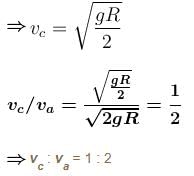
The correct answer is: (1 : 2)
Most Upvoted Answer
A bob is attached to one end of a string other end of which is fixed a...
For anti-clockwise motion, speed at the highest point should be  Conserving energy at (1) and (2) :
Conserving energy at (1) and (2) :
 Conserving energy at (1) and (2) :
Conserving energy at (1) and (2) :

For clock-wise motion, the bob must have atleast that much speed initially, so that the string must not become loose any where until it reaches the peg B.
At the initial position :
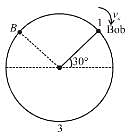
vc being the initial speed in clockwise direction.
For Vc min : Put T = 0;
For Vc min : Put T = 0;

The correct answer is: (1 : 2)

|
Explore Courses for Physics exam
|

|
Similar Physics Doubts
A bob is attached to one end of a string other end of which is fixed at pegA. The bob is taken to a position where string makes an angle of 30° with the horizontal. On the circular path of the bob in vertical plane there is a peg ‘B’ at a symmetrical position with respect to the position of release as shown in the figure. Ifvcandvabe the minimum speeds in clockwise and anticlockwise directions respectively, given to the bob in order to hit the peg ‘B’ then ratiovc:vais equal to :a)(1 : 4)b)(1 : 2)c)(1 : 3)d)(1 : 1)Correct answer is option 'B'. Can you explain this answer?
Question Description
A bob is attached to one end of a string other end of which is fixed at pegA. The bob is taken to a position where string makes an angle of 30° with the horizontal. On the circular path of the bob in vertical plane there is a peg ‘B’ at a symmetrical position with respect to the position of release as shown in the figure. Ifvcandvabe the minimum speeds in clockwise and anticlockwise directions respectively, given to the bob in order to hit the peg ‘B’ then ratiovc:vais equal to :a)(1 : 4)b)(1 : 2)c)(1 : 3)d)(1 : 1)Correct answer is option 'B'. Can you explain this answer? for Physics 2024 is part of Physics preparation. The Question and answers have been prepared according to the Physics exam syllabus. Information about A bob is attached to one end of a string other end of which is fixed at pegA. The bob is taken to a position where string makes an angle of 30° with the horizontal. On the circular path of the bob in vertical plane there is a peg ‘B’ at a symmetrical position with respect to the position of release as shown in the figure. Ifvcandvabe the minimum speeds in clockwise and anticlockwise directions respectively, given to the bob in order to hit the peg ‘B’ then ratiovc:vais equal to :a)(1 : 4)b)(1 : 2)c)(1 : 3)d)(1 : 1)Correct answer is option 'B'. Can you explain this answer? covers all topics & solutions for Physics 2024 Exam. Find important definitions, questions, meanings, examples, exercises and tests below for A bob is attached to one end of a string other end of which is fixed at pegA. The bob is taken to a position where string makes an angle of 30° with the horizontal. On the circular path of the bob in vertical plane there is a peg ‘B’ at a symmetrical position with respect to the position of release as shown in the figure. Ifvcandvabe the minimum speeds in clockwise and anticlockwise directions respectively, given to the bob in order to hit the peg ‘B’ then ratiovc:vais equal to :a)(1 : 4)b)(1 : 2)c)(1 : 3)d)(1 : 1)Correct answer is option 'B'. Can you explain this answer?.
A bob is attached to one end of a string other end of which is fixed at pegA. The bob is taken to a position where string makes an angle of 30° with the horizontal. On the circular path of the bob in vertical plane there is a peg ‘B’ at a symmetrical position with respect to the position of release as shown in the figure. Ifvcandvabe the minimum speeds in clockwise and anticlockwise directions respectively, given to the bob in order to hit the peg ‘B’ then ratiovc:vais equal to :a)(1 : 4)b)(1 : 2)c)(1 : 3)d)(1 : 1)Correct answer is option 'B'. Can you explain this answer? for Physics 2024 is part of Physics preparation. The Question and answers have been prepared according to the Physics exam syllabus. Information about A bob is attached to one end of a string other end of which is fixed at pegA. The bob is taken to a position where string makes an angle of 30° with the horizontal. On the circular path of the bob in vertical plane there is a peg ‘B’ at a symmetrical position with respect to the position of release as shown in the figure. Ifvcandvabe the minimum speeds in clockwise and anticlockwise directions respectively, given to the bob in order to hit the peg ‘B’ then ratiovc:vais equal to :a)(1 : 4)b)(1 : 2)c)(1 : 3)d)(1 : 1)Correct answer is option 'B'. Can you explain this answer? covers all topics & solutions for Physics 2024 Exam. Find important definitions, questions, meanings, examples, exercises and tests below for A bob is attached to one end of a string other end of which is fixed at pegA. The bob is taken to a position where string makes an angle of 30° with the horizontal. On the circular path of the bob in vertical plane there is a peg ‘B’ at a symmetrical position with respect to the position of release as shown in the figure. Ifvcandvabe the minimum speeds in clockwise and anticlockwise directions respectively, given to the bob in order to hit the peg ‘B’ then ratiovc:vais equal to :a)(1 : 4)b)(1 : 2)c)(1 : 3)d)(1 : 1)Correct answer is option 'B'. Can you explain this answer?.
Solutions for A bob is attached to one end of a string other end of which is fixed at pegA. The bob is taken to a position where string makes an angle of 30° with the horizontal. On the circular path of the bob in vertical plane there is a peg ‘B’ at a symmetrical position with respect to the position of release as shown in the figure. Ifvcandvabe the minimum speeds in clockwise and anticlockwise directions respectively, given to the bob in order to hit the peg ‘B’ then ratiovc:vais equal to :a)(1 : 4)b)(1 : 2)c)(1 : 3)d)(1 : 1)Correct answer is option 'B'. Can you explain this answer? in English & in Hindi are available as part of our courses for Physics.
Download more important topics, notes, lectures and mock test series for Physics Exam by signing up for free.
Here you can find the meaning of A bob is attached to one end of a string other end of which is fixed at pegA. The bob is taken to a position where string makes an angle of 30° with the horizontal. On the circular path of the bob in vertical plane there is a peg ‘B’ at a symmetrical position with respect to the position of release as shown in the figure. Ifvcandvabe the minimum speeds in clockwise and anticlockwise directions respectively, given to the bob in order to hit the peg ‘B’ then ratiovc:vais equal to :a)(1 : 4)b)(1 : 2)c)(1 : 3)d)(1 : 1)Correct answer is option 'B'. Can you explain this answer? defined & explained in the simplest way possible. Besides giving the explanation of
A bob is attached to one end of a string other end of which is fixed at pegA. The bob is taken to a position where string makes an angle of 30° with the horizontal. On the circular path of the bob in vertical plane there is a peg ‘B’ at a symmetrical position with respect to the position of release as shown in the figure. Ifvcandvabe the minimum speeds in clockwise and anticlockwise directions respectively, given to the bob in order to hit the peg ‘B’ then ratiovc:vais equal to :a)(1 : 4)b)(1 : 2)c)(1 : 3)d)(1 : 1)Correct answer is option 'B'. Can you explain this answer?, a detailed solution for A bob is attached to one end of a string other end of which is fixed at pegA. The bob is taken to a position where string makes an angle of 30° with the horizontal. On the circular path of the bob in vertical plane there is a peg ‘B’ at a symmetrical position with respect to the position of release as shown in the figure. Ifvcandvabe the minimum speeds in clockwise and anticlockwise directions respectively, given to the bob in order to hit the peg ‘B’ then ratiovc:vais equal to :a)(1 : 4)b)(1 : 2)c)(1 : 3)d)(1 : 1)Correct answer is option 'B'. Can you explain this answer? has been provided alongside types of A bob is attached to one end of a string other end of which is fixed at pegA. The bob is taken to a position where string makes an angle of 30° with the horizontal. On the circular path of the bob in vertical plane there is a peg ‘B’ at a symmetrical position with respect to the position of release as shown in the figure. Ifvcandvabe the minimum speeds in clockwise and anticlockwise directions respectively, given to the bob in order to hit the peg ‘B’ then ratiovc:vais equal to :a)(1 : 4)b)(1 : 2)c)(1 : 3)d)(1 : 1)Correct answer is option 'B'. Can you explain this answer? theory, EduRev gives you an
ample number of questions to practice A bob is attached to one end of a string other end of which is fixed at pegA. The bob is taken to a position where string makes an angle of 30° with the horizontal. On the circular path of the bob in vertical plane there is a peg ‘B’ at a symmetrical position with respect to the position of release as shown in the figure. Ifvcandvabe the minimum speeds in clockwise and anticlockwise directions respectively, given to the bob in order to hit the peg ‘B’ then ratiovc:vais equal to :a)(1 : 4)b)(1 : 2)c)(1 : 3)d)(1 : 1)Correct answer is option 'B'. Can you explain this answer? tests, examples and also practice Physics tests.

|
Explore Courses for Physics exam
|

|
Suggested Free Tests
Signup for Free!
Signup to see your scores go up within 7 days! Learn & Practice with 1000+ FREE Notes, Videos & Tests.


















